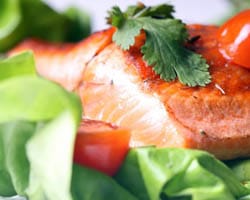
Nutritional trends come and go, but overwhelming evidence continues to support the health benefits of omega-3 fatty acids, and this has consumers around the world seeking more of this vital nutrient.
The average intake of omega-3 in the United States is estimated at only about 100 mg per day, a far cry from the recommended 1,000 to 2,000 mg per day. Natural sources are few and are not necessarily popular in the average diet – sardines and salmon, flaxseed oil, walnuts – sparking a major supermarket trend for foods fortified with omega-3.
Recently, market researcher AC Nielsen announced that omega-3 products showed a 42 percent growth in 2009. Omega-3 has already been added to numerous beverages, spreads, dairy products (like yogurts and milk), eggs, bread, pasta, nutrition bars, baked goods, and infant formula.
In 2004, the Food and Drug Administration approved a “qualified health claim for reduced risk of coronary heart disease (CHD) on conventional foods that contain eicosapentaenoic acid (EPA) and docosahexaenoic acid (DHA) omega-3 fatty acids.” Qualified health claims must be supported by significant credible scientific evidence. Research has shown that the beneficial health effects associated with omega-3 consumption include reducing the risk of heart disease and inflammation, and preventing or helping to alleviate nervous system disorders such as depression and dementia.
Just how much of a product must an individual consume, however, to obtain a protective level of these essential fats? A closer look at food labels reveals that a single serving size of a product provides only a fraction of the recommended daily intake of omega-3. Furthermore, many products don’t state how much omega-3 is in EPA or DHA forms.
From a numbers standpoint, one omega-3 egg provides only 40 mg (a regular egg has only 4 mg of omega-3 per egg). To reach the minimum 1,000 mg recommendation for adults, 25 omega-3 eggs must be eaten.
Is paying a premium for omega-3 pasta worth the extra cost? Both Barilla Plus & Omega-3 Pasta and Heartland Plus ALA Omega-3 supply 360 mg in 1 cup of uncooked pasta. Three servings of pasta will meet minimum daily omega-3 needs.
Based on numerous studies establishing DHA’s critical role in the optimal development of the brain and vision, most health experts recommend 100 to 450 mg of omega-3 for infants and toddlers. While every little bit of dietary DHA helps, counting on only one or two fortified sources will not cut it and may deliver more than you bargained for.
A serving of Yoplait Kids Yogurt Drink provides 16 mg of DHA. It also supplies 10 grams of sugar. To reach a meager 100 mg of DHA, a child would have to eat 6.25 containers, ingesting 62.5 grams of sugar. To reach 450 mg, that’s 28 servings – and 280 grams of sugar.
Debbie Fischer, a mother of three from Minneapolis, told Naturally Savvy she is concerned that shoppers, especially parents are being misled by advertising into believing that these omega-3 products will fulfill a child’s nutritional needs.
Cold-water, fatty fish remains unsurpassed as the top food source of omega-3. Four ounces of mackerel supplies 2,300 mg. That breaks down to 986 mg a day if mackerel is eaten three times in a week. The same amount of Pacific salmon provides 1,640 mg of omega-3, and canned tuna offers 1,000 mg.
Taking an omega-3 purified fish oil supplement is the best way to boost omega-3 intake and guarantees a specific amount of DHA and EPA. Pleasant-tasting DHA supplements are available for infants and children in age-appropriate doses. Moreover, a cost-comparison of fish oil supplements and omega-3 fortified foods proves it makes sense to go straight to the source.




